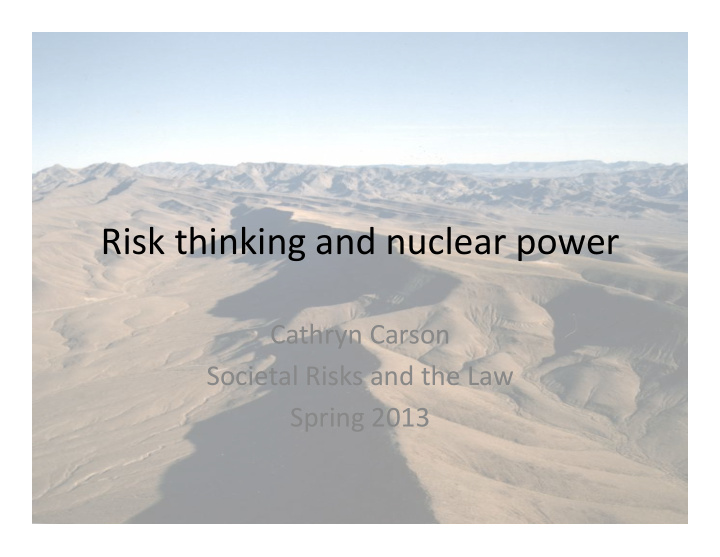



Risk ¡thinking ¡and ¡nuclear ¡power ¡ Cathryn ¡Carson ¡ Societal ¡Risks ¡and ¡the ¡Law ¡ Spring ¡2013 ¡
How ¡does ¡the ¡history ¡of ¡nuclear ¡power ¡ intersect ¡with ¡the ¡history ¡of ¡risk ¡thinking? ¡ 1960s ¡– ¡70s ¡– ¡80s • comparison ¡tables ¡of ¡risks ¡ • metric ¡of ¡deaths ¡ • psychometric ¡studies ¡ • risk ¡communicaAon ¡research ¡ courtesy ¡of ¡the ¡Nuclear ¡ Regulatory ¡Commission ¡ • why ¡is ¡the ¡public ¡so ¡fearful ¡of ¡nuclear ¡power? ¡ • emoAon, ¡posiAon, ¡and ¡trust ¡ hIp://www.nrc.gov/reading-‑rm/doc-‑collecAons/nuregs/brochures/br0308/ ¡
From ¡the ¡NRC’s ¡website ¡ hIp://www.nrc.gov/reading-‑rm/doc-‑collecAons/nuregs/brochures/br0308/ ¡ Understand ¡the ¡pros ¡and ¡cons ¡of ¡using ¡risk ¡comparisons ¡ Risk ¡comparisons ¡may ¡help ¡your ¡audience ¡understand ¡more ¡clearly ¡how ¡an ¡unfamiliar ¡ risk ¡compares ¡to ¡a ¡risk ¡that ¡is ¡more ¡familiar. ¡However, ¡using ¡this ¡type ¡of ¡risk ¡ comparison ¡can ¡backfire. ¡While ¡some ¡members ¡of ¡the ¡public ¡may ¡appreciate ¡your ¡ efforts ¡to ¡clarify ¡risks, ¡others ¡may ¡feel ¡that ¡you ¡are ¡trivializing ¡risks ¡important ¡to ¡them. ¡ Comparing ¡the ¡risks ¡of ¡living ¡near ¡a ¡nuclear ¡power ¡plant ¡to ¡lifestyle ¡choices, ¡such ¡as ¡ smoking, ¡or ¡to ¡other ¡risks ¡the ¡public ¡voluntarily ¡assumes, ¡like ¡driving, ¡may ¡suggest ¡to ¡ the ¡public ¡that ¡you ¡are ¡being ¡manipulaAve ¡and ¡trying ¡to ¡co-‑opt ¡their ¡decisions ¡about ¡ what ¡risks ¡are ¡acceptable. ¡Risk ¡communicaAon ¡pracAAoners ¡have ¡learned ¡the ¡hard ¡ way ¡that ¡relying ¡on ¡risk ¡comparisons ¡to ¡overcome ¡fears ¡about ¡exposure ¡to ¡radiological ¡ hazards ¡can ¡actually ¡damage ¡your ¡credibility. ¡ Risk ¡comparisons ¡work ¡best ¡when ¡you’re ¡explaining ¡risks ¡to ¡people ¡with ¡whom ¡you’ve ¡ built ¡some ¡level ¡of ¡trust ¡and ¡understanding. ¡Believing ¡that ¡your ¡moAves ¡are ¡well-‑ intended, ¡this ¡audience ¡is ¡willing ¡to ¡accept ¡your ¡risk ¡comparisons ¡in ¡good ¡faith. ¡
Due date: April 30, at the beginning of class at 2:10pm Homeworks must be turned in on paper (hard-copy), at the start of class. Late homeworks (i.e. submitted after 2:10pm) will NOT be accepted. Q1) In what ways was the California debate over nuclear power in the 1960s and 1970s framed as a debate about risk? List at least 3 distinct kinds of risk that were part of public discussion. Explain what was at stake for each in a sentence or two. Q2) People often say the notion of risk has been around for a long time, tracing it back to gamblers and such. If that’s the case, why did it take centuries for “risk assessment” and “risk communication” get started as domains of academic research and policy practice? Q3) Do risk comparisons actually help you make decisions about what to do in real life? Give one example where they do (or have) and another example when they don’t (or haven’t). Unless you’re so consistent that you entirely live on one side or another …. Q4) How about understanding cognitive biases? Does it make you act differently? Q5) And how about working through cases like the Monty Hall problem, poker hands, or other classic examples? If you’re not going to be on a game show and you don’t care for poker, what do you take away from calculating through these artificial exercises? (Bonus: Why do you think statistics is so often taught with examples from card games or sports?)
liability ¡ ¡ catastrophic ¡accidents maximum ¡ credible ¡ accident ¡ ¡ siAng ¡ guidelines public ¡ acceptance ¡ ¡
Reactor ¡Safety ¡Study, ¡ a.k.a. ¡Rasmussen ¡Report, ¡ a.k.a. ¡WASH-‑1400 ¡ 1975 ¡ Fig. ¡4-‑3 ¡ Subtasks ¡in ¡the ¡ QuanAficaAon ¡of ¡ RadioacAve ¡Releases ¡
Reactor ¡Safety ¡Study, ¡ a.k.a. ¡Rasmussen ¡Report, ¡ a.k.a. ¡WASH-‑1400 ¡ 1975 ¡ Fig. ¡4-‑4 ¡ Simplified ¡Event ¡Trees ¡for ¡ a ¡Large ¡LOCA ¡
Recommend
More recommend